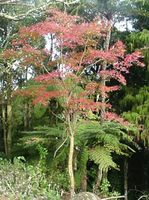
Maple tree in my garden

Autumn leaves are now making themselves noticed!
Autumn leaves are an old favourite in many junior classrooms but for all that they are not used as well as they could be.
Making students aware of their environment, by educating their senses and imagination, is regarded by many as a vital ingredient in a person’s education. Certainly it has been an important part of my own philosophy and teaching. I have a feeling that making use of the immediate environment, particularly incidental events, is not as common as it once was. If so, it would be a shame.
David Elkind, in his book the ‘Hurried Child’, writes.
‘Over the years I have made a practice to take a little time each day to enjoy a sunset, watch a sparrow, admire a snowflake, Such moments should be shared with children.’
This practice should be part of every school day.
Helping children relate to their environment is captured by Walt Whitman’s poem ‘Leaves of Grass’:
‘The schooners, the waves, the clouds.
the flying sea crow, the fragrance
Of the salt marsh and mud, the horizon’s edge.
These become part of that child who went forth every day
And now goes and
Will always go forth everyday'.
This connection with ones environment is important. From such experiences arise curiosity, questions, thinking, poetic language and the expressive arts and, most of all, a sense of place.
So look freshly at those autumn leaves with your class.
Visit the trees. Collect leaves. Kick them into the air. Observe the various graduations of leaves. See where the fallen leaves end up. Count and measure what you can. Collect the poetic thoughts and questions the children have to offer.
Back in classs build up a display around the topic. Include their question and their current views (and send then home to research answers). Get the children to do slow detailed observational drawing and, while they are doing this, get them to think of further questions to research. Get them to consider what is happening. Why do trees have leaves? Why don’t other trees lose all their leaves at any one time?
How far do the leaves fall ( on a still day)? Where do most of them fall (use a line to count the leaves)?
Make a display of the graduation of colour change in leaves from any one tree and research why?
Students could research the species of autumn trees in the school grounds.
They could write small three lines poems about autumn leaves ( one thought about the leaves still on the tree; one thought about a leaf falling; one thought about the leaves on the ground, or what happens to them).They could compose songs about autumn leaves and put them to music. They could create dances based on falling leaves.They could paint imaginative autumn leaves, extending the ideas from their close observation.
In the above activities the full range of multiple intelligences would be covered!More imporantly the process of looking at any event through a variety of frameworks would become natural to them.
Ideas for teaching observation through drawing, to develop awareness and environmental resources are avaliable on our website.
4 comments:
Beautiful form and colour Bruce - you wisely have limited the amount of lawn in your garden thus giving you more time to BLOG!! DC
Very perceptive DC.
Hope you are still fooling most of the people most of the time!
Might be over your way later!
We must find time for a whine or is wine!
You are, right. How often is our own backyard overlooked as an educational resource. It makes sense that children should begin with their own environment, social history and natural setting. Many children do not know anything about the plants in their own school garden or the significance of monument down the road from the school, for example. An aesthetic appreciation of our natural environment can be the spring board for lot of creative learning as well as contributing to the development of a sense of place and self for the learner.
Of course you are right.In our rush to 'deliver the curriculum' we overlook the source of real curiosity - the lives, concerns , questions, and the chidren's own environment. All too sinple I presume, but the source of authentic learning. This natural learning serves children well until they get to school then it is slowly lost.
Post a Comment